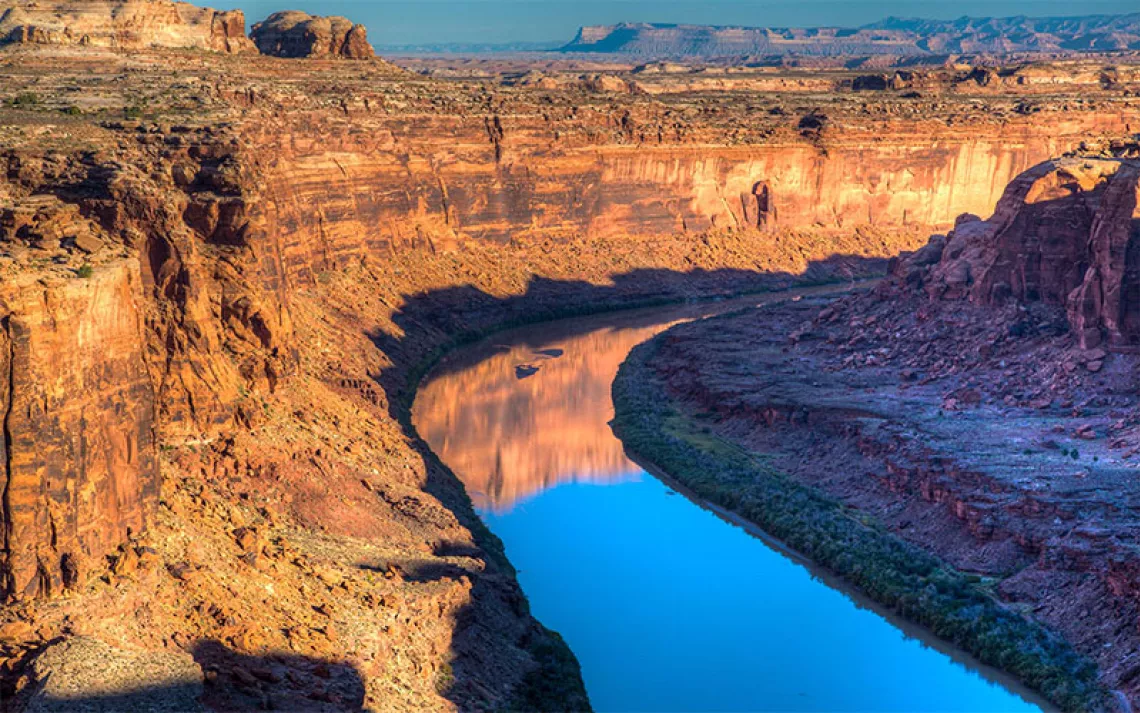Seeds of Resistance
Native-led campaigns are at the forefront of today's climate and justice movements

Photo by Shane Balkowitsch
Most of the people who sit for photographer Shane Balkowitsch at his North Dakota studio are enrolled members of Northern Plains nations—Arikara, Crow, Lakota. Other subjects—Diné and Comanche and Seminole—come from much farther away. They typically pose wearing traditional regalia or holding family heirlooms. Balkowitsch (who has been given an honorary Indigenous name by the Hidatsa) uses an archaic wet-plate method that, he says, is "like writing in molecules of silver." The resulting portraits have a timeless aspect, as if reality has been briefly arrested.
When I first saw Balkowitsch's portrait of then-representative Deb Haaland, I appreciated the artistry—and also felt some unease. I was reminded of Edward Curtis, the early-20th-century photographer who took thousands of portraits that stereotyped Native Americans. Curtis believed he was making a historical record of what he thought was a "vanishing race." But his romanticization of Native peoples contributed to their attempted erasure—in Curtis's case, by trying to lock Native Americans in the past.
The 512 Indigenous people who have sat before Balkowitsch's large-format camera evidently have a different idea. They have, in effect, seized the means of cultural production by reclaiming an old technology to forge a 21st-century Indigeneity.
"These images show that we are a people that could not be erased from this earth," writes Margaret Yellowbird-Landine (Sahnish, Hidatsa, and Assiniboine) in a foreword to Balkowitsch's monograph Northern Plains Native Americans. Dakota Goodhouse, a historian who is Hunkpapha Lakota, told me that the portraits provide a jolt of "self-recognition." After posing for her portrait in 2019, Deb Haaland said that Balkowitsch's project "works to reframe the Indigenous story."
So, too, does the very presence of a Native American secretary of the interior. Haaland's ascension to the highest levels of US government has made her "an Indigenous icon," as veteran journalist Jenni Monet (Laguna Pueblo) writes in a vivid profile ("A Living Testament"). "She's a meme. She's a GIF. She's some artist's latest beadwork."
Among Native millennials, Haaland is often referred to as "Auntie Deb." It's a fitting honorific for the interior secretary, who was propelled into Biden's cabinet by a grassroots campaign led by the same Indigenous activists spearheading resistance against the economy of greed, exploitation, and wanton extraction. From the coastal waters of the Pacific Northwest (where the Lummi Nation defeated a proposed coal-export terminal) to the Northern Plains (where Lakota tribes helped to kill Keystone XL) to the Southwest (where a coalition of five nations have worked to establish and then defend Bears Ears), Indigenous organizers are demanding that sacred places be protected and that their nations' treaties with the United States be honored.
Vanishing? Hardly. Native-led campaigns are often at the forefront of today's climate and justice movements—a real victory given white settlers' centuries-long effort to exterminate Native cultures. During Secretary Haaland's first summer in her post—and just as Anishinaabe activists were orchestrating a blockade of Line 3—came horrific revelations of hundreds of unmarked graves at government- and Catholic Church–run Indigenous boarding schools in Canada. In The Washington Post, Haaland wrote that the atrocious history of Indian schools in the United States and the perseverance of Indigenous cultures today offer "a profound lesson for me about the resilience of our people."
While the gruesome news seemed to barely dent the dominant-culture consciousness (where were the mass marches denouncing the cemeteries at schools?), Native Twitter was inflamed. On the platform, I kept seeing one quote ricocheting among handles and retweets. It's a century-old resistance aphorism popularized by the Zapatista revolt of the 1990s. The line spread like wildfire, promising new life: "They tried to bury us. They didn't know we were seeds."
This article appeared in the Fall quarterly edition with the headline "Seeds of Resistance."
 The Magazine of The Sierra Club
The Magazine of The Sierra Club



